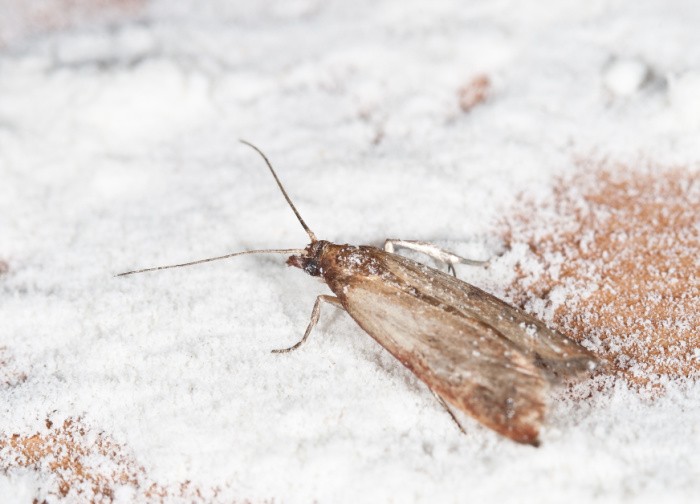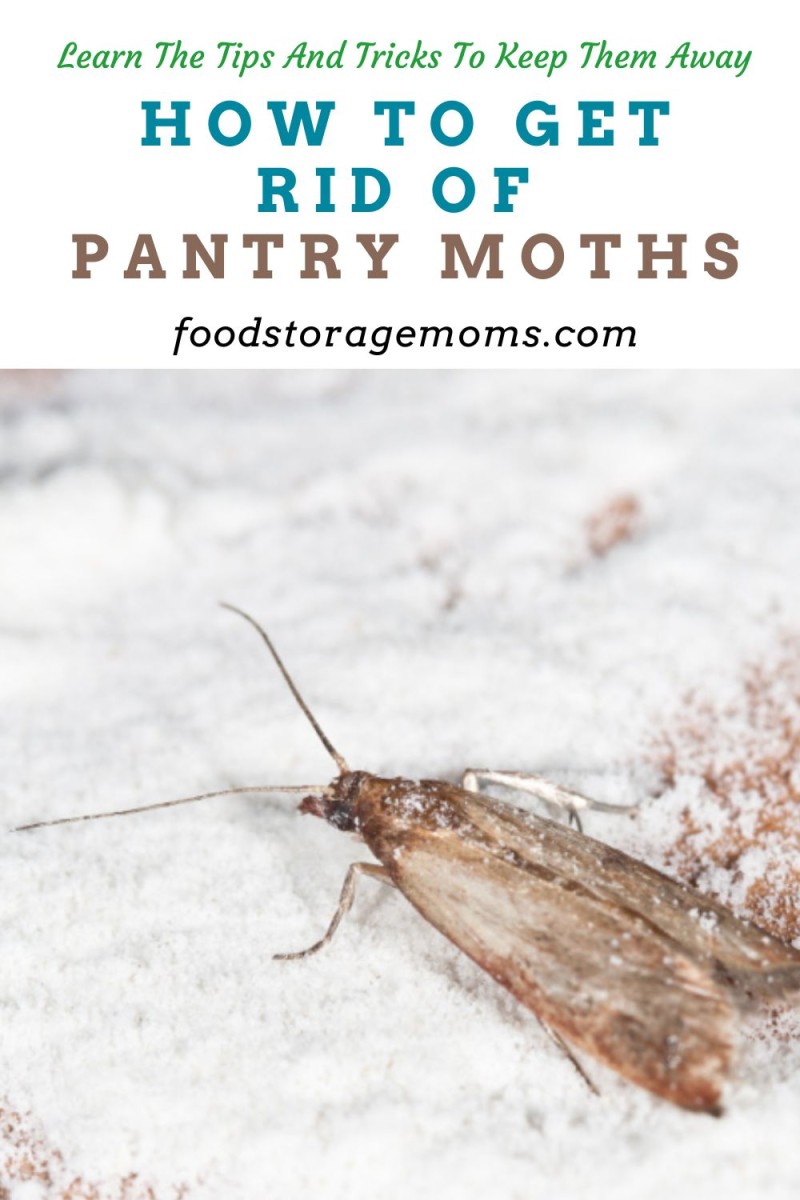How To Get Rid Of Pantry Moths

I really never thought I would write a post about how to get rid of pantry moths. I had never heard of pantry moths, sometimes called meal moths, grain moths, or Indianmeal moths until a few years ago. I was at a friend’s house and she mentioned, “I am so sick of these tiny moths in my kitchen!”
They didn’t look like typical moths, like the ones you see flying around outside light bulbs on your back patio. Well, of course, I had to look really closely at the moths. I’m updating this post from a few years ago because I hope it helps a family or two. With the new year, many of us are cleaning and organizing so we’re ready to face the new year with confidence. Keeping areas in the kitchen and other food storage spaces clean and organized is a great way to start.
I’m not sure why I decided to research this issue, but I always like learning new things. The thing that’s different about these moths is the fact they are only about 1/2 an inch in length. I have only seen larger moths like the ones you see in closets. I had my iPhone with me and my friend and I both decided to look up why these tiny moths could possibly be hanging out there. Lo and behold, they are called pantry moths.
Pantry moths look like many other varieties, but they are smaller than most. If you think you have one of those pantry moth infestations, we’re here to help you eradicate the little pests.

How to Get Rid of Pantry Moths
Pantry moths aren’t something that anyone really wants to see. Frankly, adult moths and their pantry moth larvae are kind of ugly, and I surely don’t want them hanging around my house. I want to share some tips for getting rid of them. And again, pantry moths aren’t harmful to humans, but they can do a lot of damage to the human and pet foods in your pantry. Who wants that?
Invest in Airtight Containers
I store all my dry foods and other staple foodstuffs in mason jars or hard commercial plastic food containers like these: Rubbermaid Containers with Lids. They are air-tight and I store all sorts of things in them. I still buy some OXO containers, but these Rubbermaid ones are my favorite. You need to have airtight containers to keep these moths out of your potential food sources the moths love to eat. Hopefully, you can grab some of these containers to help keep insects like these pantry moths out of your food storage stash.
Inspect Your Pantry
It’s one thing to have pantry moths and then to buy containers to keep them from spreading, but you really need to find the source of the infestation. Take the time to inspect your pantry and clean it out, particularly if you see moths or the webs they make. It’ll be worth it when you can get rid of the moths for good. You may not know this, but moths love pasta, flour, cereal, the food you give your pets, and baking mixes.
You’ll have to go through any food that is not sealed to see if they’re inside the package. It may truly amaze you what pantry moths can find and then climb into. While you’re inspecting your pantry, look for larvae and the cocoons they make before becoming adult male moths or female moths. If found, you’ll want to get rid of that portion of food. I didn’t realize it, but moths are called a pupa when they are in the cocoon stage.
You’ll want to kill the pantry moths whether they are in the adult pantry moth stage, still in the cocoon, at the young larvae stage, or even while still an egg. The adult female pantry moth can lay up to 400 pantry moth eggs in your dry food products, so an infestation can be pretty devastating.
It may very well be the case that the dry food product you purchased actually contained moths in various stages. Always purchase your dry food products from well-known and trusted brands and packages. If you have any questions, open up the package and inspect the product before you put it to use. If you’ve already opened some packages, pay special attention to those if they haven’t been placed in airtight containers with a firm seal.
Freeze Your Grains
Over the years, I’ve found that freezing my grains is a really good idea. Obviously, moths can’t get into the freezer, so this is a really good idea for storing any kind of grain item. You do want to make sure you clean out your pantry and get rid of any infested products. It’s best to just store the newly purchased items in the freezer. You can store any flour, baking products, or nuts in the freezer to help keep moths and other pests out. It will also lengthen the storage time before those items go rancid.
Monitor Your Pantry
Once you get rid of the moths in your pantry, you need to keep monitoring the situation. Check back fairly often so you can see if any pantry moths are there. Prevention is key, but you also need to make sure you’re doing your due diligence and making sure there is nothing in your pantry like ants or roaches.
How Do Pantry Moths Come Into My House?
Pantry moths will come into your house via a package of flour, rice, beans, cracker or cereal, chips, or most any food item from the supermarket. They have teeny tiny, almost invisible eggs that are in food packages and hatch larvae that turn into moths after the cocoon stage.
You may see these tiny black/brown beetles that are very tiny bugs in cornmeal, birdseed, flour, cereal, etc. You may see these cream-colored worm-like critters climbing on your walls. The first thing you need to do is look for the oldest packages of food or spices you have. Yep, they love all the unopened packages as well. Oh, and those partially closed spice containers are a dream come true for these critters.
Places To Look For Pantry Moths:
- Unopened packages, check the cereal boxes, and the unopened bags, and check the creases of the bags inside all boxes
- Cracks in your cupboards
- Spice containers
- Breadcrumbs, even if unopened
- Boxes with baggies-they love to hide
- Check dried flowers
- Check under lids, they can hide anywhere
- Cupboard hinges
- Vacuum all floor moldings, empty the bag, and take the dust bag out to the trash. If your vacuum is a bagless variety, be sure to wash out the dust compartment with your cleaning solution a couple of times.
- They hide in the cupboard pinholes, it’s a perfect place to lay eggs.
- Use a pantry moth trap like this one: Pro-Pest Pantry Moth Traps. The female emits a similar pheromone substance as these traps when she is ready to mate. The male panty moths will follow the scent to the traps. The male critters will flock to the sticky mat looking for the female pantry moths. This should hopefully stop the pantry moth life cycle.
- Some people think if they put their food in the freezer it will kill the pantry moths in the larvae stage. In the cocoon, they can actually go into a dormant stage sometimes and wake up when back in the warmer temperatures and comfort of a cupboard. You’re much better off placing them in the freezer before you open them, thus keeping the moths out until you’re ready to put them in the air-tight containers or immediately use them. A week in the freezer usually does the trick.
- Pet treats, dog food, and bird seed are a delicacy to these pests.
- Children’s macaroni artwork is tasty, throw out the artwork after it’s been on display for a few days.
- You may need to remove all cupboard liners and shelf paper. They hide underneath the liners if not firmly put in place. Vacuum everywhere, just in case.
- Nuts need to be put in airtight containers, mason jars, or tight-sealing containers. Unless they are covered with seasonings, you may want to wash them first.
- Chocolate, as in chocolate chips, can be a favorite for them just like for us. They also need to go into airtight containers.
- I never buy a damaged box of food at the store because they may have some eggs hiding inside.
- Jello gelatin boxes can also hide the eggs. I put the whole box in an airtight container as soon as I get them home from the store.
- They have been known to chew through baggies, that’s why I love hard plastic airtight containers for my stored food.
How Do I Clean The Pantry Moth Hiding Places?
I helped my friend by totally taking EVERYTHING out of the cupboards. We inspected for webs, larvae, eggs, cocoons, and adult moths with wings. We both washed down the top and underneath the shelves in each cabinet. Yep, they hide in crevices and corners.
Things you will need:
- Bleach/Clorox Spray or undiluted vinegar
- Garbage bags
- Vacuum
- Paper towels to dispose of the webs, beetles, larvae, and moths
- Hot soapy water with rags you can throw out
- Wash all cupboards with hot soapy water. I went one step further, I brought out the BIG guns (bleach mixture): Clorox Spray. You can also use undiluted vinegar. I picked up my cleaning solutions at the local supermarket. We sprayed, wiped, and sprayed again all the cupboards, baseboards, countertops, and window seals. We sprayed the hinges on the cupboards and the edges of the shelf liners as well. Any liner that looked frayed, buckled, or less than tightly affixed, we pulled out and replaced. Oh, how they love to hide. We wiped down everything we thought a moth family might use to hide. She has not seen ANY pantry moths for months since we did our deep clean. Hopefully, we got the infestation under control and eradicated.
Can pantry moths be harmful to humans or pets?
There isn’t any record of pantry moths biting or otherwise harming humans or our pets. They can cause some baking goods to sour during a severe infestation, but they won’t contaminate the food or cause diseases as we see with houseflies.
Won’t the pantry moths just go away, particularly when it gets cold outside?
If you leave the moths to do their thing, the infestation will only get worse, no matter what the temperature outside is. So, inspect your food right after the purchase, look for signs of the moths as you open and use the dry food products, carefully discard any products with moths, and do the cleanup as discussed above.
Final Word
I hope you’re able to use these tips to help you learn how to get rid of pantry moths in your kitchen and/or pantry. If you suspect that you have pantry moths, these tips should help you get rid of them. I’d love to know if you have any tips to add to this list. May God Bless this world, Linda.
Copyright images: Pantry Moth AdobeStock_313049054 by Tomasz, Pantry Moth AdobeStock_384685546 by Jorge, Pantry Moth AdobeStock_68670040 By Peter Jurik
The post How To Get Rid Of Pantry Moths appeared first on Food Storage Moms.
